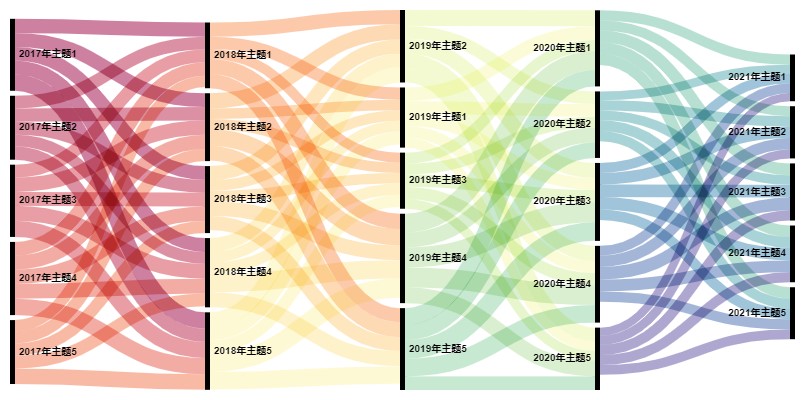 PDF(2212 KB)
PDF(2212 KB)


 PDF(2212 KB)
PDF(2212 KB)
 PDF(2212 KB)
PDF(2212 KB)
词共现频次变化视角下的动态主题识别研究
Research on Dynamic Topic Recognition Based on the Change of Word Co-Occurrence Frequency
[目的/意义]主题识别研究对于理清领域内的知识结构与研究热点非常重要,对领域主题进行动态识别,可以很好地帮助研究人员了解和掌握领域的发展态势及未来走向。[方法/过程]利用张量的数据结构形式,在词共现矩阵中融入时间维度,只需一次聚类便可进行动态主题的识别。[结果/结论]张量结构及非负张量分解算法为词共现频次变化视角下的动态主题识别提供一种新的方法,该方法相较于传统方法更为简单快捷,有效避免了信息的损失。
[Purpose/Significance] The research on topic recognition is very important to clarify the knowledge structure and research hotspots in the field. Dynamic identification of domain topics can help researchers understand and master the development trend and future trend of the field. [Method/Process] Using the data structure form of tensor, this paper integrated the time dimension into the word co-occurrence matrix, and only needed one clustering to identify the dynamic topic. [Result/Conclusion] Tensor structure and non-negative tensor decomposition algorithm provide a new method for dynamic topic recognition from the perspective of word co-occurrence frequency change. Compared with traditional methods, this method is simpler and faster, and effectively avoids the loss of information.

关键词共现 / 非负矩阵分解 / 非负张量分解 / 动态主题识别 / 知识管理
keyword co-occurrence / non-negative matrix factorization / non-negative tensor factorization / dynamic topic recognition / knowledge management
| [1] |
BUSH V. As we may think[J].The Atlantic monthly, 1945 (7):1-2 .
|
| [2] |
刘向,马费成,陈潇俊,等.知识网络的结构与演化——概念与理论进展[J].情报科学,2011,29(6):801-809.
|
| [3] |
巴志超,杨子江,朱世伟,等.基于关键词语义网络的领域主题演化分析方法研究[J].情报理论与实践,2016,39(3):67-72.
|
| [4] |
王莉亚.主题演化研究进展[J].情报探索,2014(4):29-32.
|
| [5] |
邵作运,李秀霞.引文分析法与内容分析法结合的文献知识发现方法综述[J].情报理论与实践,2020,43(3):153-159.
|
| [6] |
邹丽雪,王丽,刘细文.利用引文构建的主题模型研究进展[J].图书情报工作,2019,63(23):131-138.
|
| [7] |
祝清松,冷伏海.基于引文主路径文献共被引的主题演化分析[J].情报学报,2014,33(5):498-506.
|
| [8] |
黄福,侯海燕,任佩丽,等.基于共被引与文献耦合的研究前沿探测方法鄰选[J].情报杂志,2018,37(12):13-19,35.
|
| [9] |
宋艳辉,武夷山.基于作者文献耦合分析的情报学知识结构研究[J].图书情报工作,2014,58(1):117-123.
|
| [10] |
张洁,王红.基于词频分析和可视化共词网络图的国内外移动学习研究热点对比分析[J].现代远距离教育,2014(2):76-83.
|
| [11] |
叶春蕾,冷伏海.基于共词分析的学科主题演化方法改进研究[J].情报理论与实践,2012,35(3):79-82.
|
| [12] |
奉国和,孔泳欣.基于时间加权关键词词频分析的学科热点研究[J].情报学报,2020,39(1):100-110.
|
| [13] |
储节旺,钱倩.基于词频分析的近10年知识管理的研究热点及研究方法[J].情报科学,2014,32(10):156-160.
|
| [14] |
姜鑫,王德庄,马海群.关键词词频变化视角下我国“科学数据”领域研究主题演化分析[J].现代情报,2018,38(1):141-146,161.
|
| [15] |
赵丽梅,张花.我国大数据时代数字图书馆研究前沿分析——基于共词分析的视角[J].情报科学,2019,37(3):97-104.
|
| [16] |
唐果媛,张薇.基于共词分析法的学科主题演化研究进展与分析[J].图书情报工作,2015,59(5):128-136.
|
| [17] |
胡吉明,陈果.基于动态LDA主题模型的内容主题挖掘与演化[J].图书情报工作,2014,58(2):138-142.
|
| [18] |
杨超,朱东华,汪雪锋,等.专利技术主题分析:基于SAO结构的LDA主题模型方法[J].图书情报工作,2017,61(3):86-96.
|
| [19] |
KIM J, HWANG M, JEONG D H, et al. Technology trends analysis and forecasting application based on decision tree and statistical feature analysis[J]. Expert systems with applications,2012,39(16):12618-12625.
|
| [20] |
WALTMAN L, VANECK N J. Some comments on the question whether co-occurrence data should be normalized[J].Journal of the American Society for Information Science and Technology,2007,58(11):1701-1703.
|
| [21] |
LEYDESDORFF L. Should co-occurrence data be normalized? a rejoinder[J].Journal of the American Society for Information Science and Technology,2007,58(14):2411-2413.
|
| [22] |
van ECK N J, WALTMAN L. How to normalize cooccurrence data? an analysis of some well-known similarity measures[J].Journal of the American Society for Information Science and Technology,2009,60(8):1635-1651.
|
| [23] |
PAATERO P, TAPPER U. Positive matrix factorization: a nonnegative factor model with optimal utilization of error estimates of data values[J]. Environmetrics, 1994,5(2):111-126.
|
| [24] |
章祥荪,张忠元.非负矩阵分解:模型、算法和应用[J].重庆师范大学学报(自然科学版),2013,30(6):1-8.
|
| [25] |
吴继冰,黄宏斌,邓苏.网络异构信息的张量分解聚类方法[J].国防科技大学学报, 2018,40(5):146-152,170.
|
| [26] |
熊李艳,何雄,黄晓辉,等.张量分解算法研究与应用综述[J].华东交通大学学报, 2018,35(2):120-128.
|
| [27] |
程齐凯,王晓光.一种基于共词网络社区的科研主题演化分析框架[J].图书情报工作, 2013,57(8):91-96.
|
| [28] |
LUO J, GWUN O. A comparison of sift PCA-SIFT and SURF[J]. International journal of image processing,2009,3(4):143-152.
|
| [29] |
CICHOCKI A,ZDUNEK R,PHAN A H,et al. Nonnegative matrix and tensor factorizations:applications to exploratory multi-way data analysis and blind source separation[M].Hoboken:Wiley Publishing, 2009.
|
| [30] |
熊李艳,何雄,黄晓辉,等.张量分解算法研究与应用综述[J].华东交通大学学报, 2018, 35(2):120-128.
|
席崇俊:提出论文思路,设计实验,撰写论文
刘文斌:数据处理,审校论文
丁楷:数据处理,审校论文
/
| 〈 |
|
〉 |